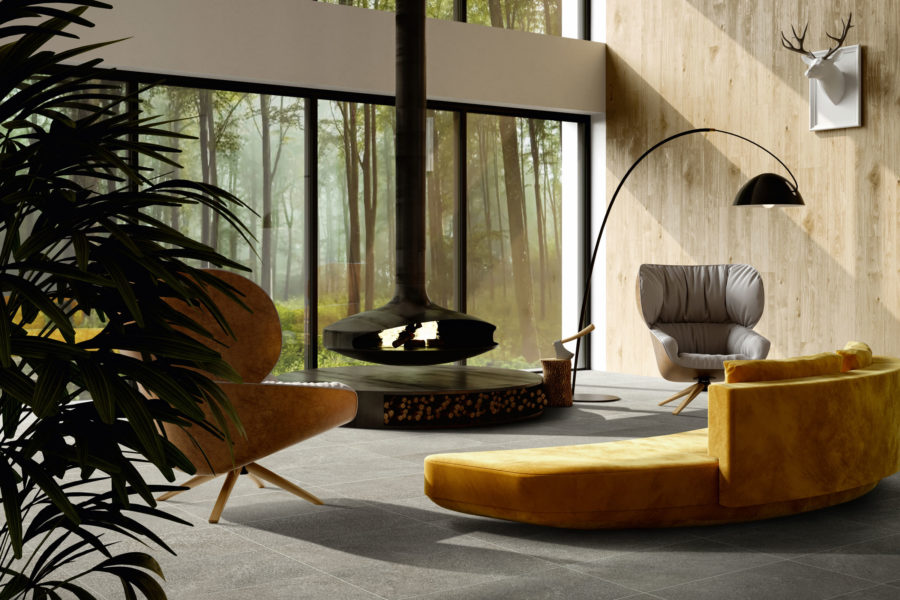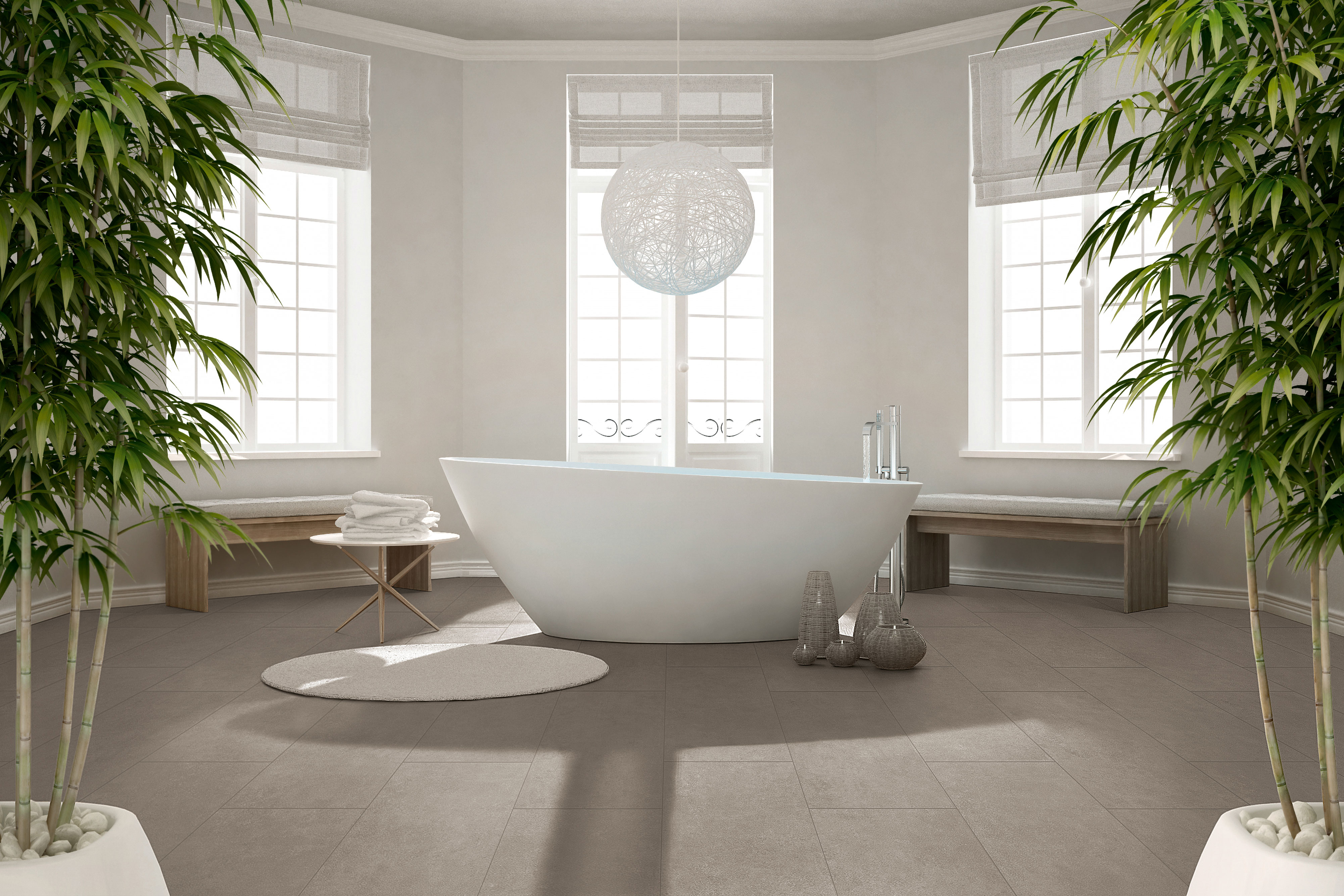For the past couple of years, the global pandemic has kept us in our homes, taught us the importance of easily cleaned surfaces, heightened our awareness of microbes around us, and generally shone a light on the home environment. As we spend more time indoors, the chemical and other exposures in that environment become more important to us. In other words, indoor air quality (IAQ) is important and impactful to our overall health. When it comes to building and design, porcelain tile can present solutions for several IAQ-related issues.
The ancient Romans first recognized the value of porcelain tile in homes and public spaces, and many of their tile murals remain beautiful today, standing the test of time. Porcelain tile is easily cleaned, hygienic, doesn’t support microbial growth, doesn’t contribute gases or particles to impair IAQ, can be Red List–free, and is made of all-natural materials. It has no plastic, petrochemicals, or toxicity.
To compound the current pandemic situation, the impacts of climate change—manifesting as increased storms, droughts, and other extreme weather events—occupy the headlines. Let’s explore the reasons why porcelain tile can help solve these varying health challenges while also reducing a building’s contributing embodied carbon footprint.
It’s Healthy
According to the dictionary, hygienic indicates that something is conducive to maintaining health and preventing disease, especially by being clean. Porcelain tile fits this bill perfectly. It’s nonporous so it provides no foothold for mold or other microbes to grow. Using approved installation methods, along with modern non-cement grouts, provides for a completely waterproof and hygienic installation. As an added bonus, porcelain tile does not need harsh chemicals for cleaning. Since there is no place for microbes to hide, cleaning with clear water is usually adequate to render a clean surface. Tougher dirt may require a mild household cleaner.
Porcelain tile supports healthy living spaces in other ways besides being easy to clean. It doesn’t support microbial growth, particularly mold. Research at Clemson University found that of sterile flooring samples—including porcelain tile and luxury vinyl tile (LVT)—when inoculated with mold spores only the LVT supported mold growth and reproduction. Porcelain tile, containing no available carbon or volatile organic compounds (VOCs), did not support mold growth. Considering what is known about the toxicity and allergenicity of mold spores, for potentially wet applications such as kitchens and baths, porcelain tile certainly represents the healthier option.
Another positive attribute of porcelain tile that supports health and safety in building spaces is the use of safe, natural raw materials. Porcelain tiles are generally made of clay, sand, and feldspar. These materials used along with modern glazes result in a tile containing no Red List chemicals. The Red List is a compilation of “harmful to humans” chemicals compiled by the International Living Futures Institute as part of its Living Building Challenge. Products containing Red List chemicals cannot be used in buildings achieving their Living Building designation. Few buildings aspire to the Living Building designation, but Red List avoidance is a good standard to help ensure a safe living space.
Many other flooring materials like LVT and carpet are made of plastics and other petrochemicals. These materials introduce a plethora of readily available chemicals to the built space, generally through VOC off-gassing. As mentioned earlier, porcelain tile contains no VOCs. As a result, porcelain does not contribute to degraded indoor air quality. This pairing of no VOCs and no Red List chemicals offers a safe and healthy flooring choice.
A third way porcelain tile can support occupant’s health is through the implementation of biophilic design. Biophilic design is a concept used within the building industry to increase occupant connectivity to nature through the use of included nature, accessible nature, as well as space and place conditions. Used at both the building and city-scale, it is argued that this idea has health, environmental, and economic benefits for building occupants and urban environments, with few drawbacks. Porcelain tile is produced in a variety of finishes related to nature such as stone, wood, and others that evoke movement, forests, and more. The inclusion of such tile finishes in an intentionally designed biophilic space contributes to an overall feeling of calmness and tranquility there.
It’s Sustainable

Photo courtesy of MILE®stone
Among flooring materials, porcelain tile is recognized as a highly sustainable choice. Modern porcelain tile manufacturing employs a variety of sustainable practices, and the installed product has attributes that contribute to the sustainability of the building where they are installed. Common sustainability efforts in the manufacturing process include high scrap recycling rates, use of offsite recycled material, water reuse, and efficient use of energy (natural gas and electricity).
As an added incentive, thoughtful implementation of sustainability efforts in manufacturing can result not only in a sustainable product but also in decreased manufacturing costs providing a cost-effective choice. Energy efficiency obviously results in cost savings, and recycled materials are frequently less costly than virgin raw materials. Recycled content is a significant element in porcelain tile’s sustainability portfolio. To support this, many porcelain tile manufacturers are active participants in the circular economy. With porcelain tile’s use of recycled materials, long life cycle, and ability to be recycled, there is a reduction or elimination of landfill waste. Since sustainability goals and tools are constantly in flux, to be effective their ongoing use requires that sustainability be integral to the manufacturer, not simply a PR or greenwashing tool.
In the built space, installation of porcelain tile, mortar, grout, and backer board provides a significant thermal mass, which reduces peak heating and cooling demands and helps moderate temperature swings in the home. This means less work for the HVAC system and more energy savings for the owner. Intentional design where the floor is exposed to southern facing windows to warm it, for example, can enhance the thermal mass benefits of a porcelain tile installation.
Unless there is a strong desire to use harsh cleaners for sterilization purposes, porcelain tile can usually be cleaned with only clear water, reducing chemical exposures in the home and also avoiding the larger environmental impacts of their manufacture and transport. This aspect along with reduced chemical exposures from the product itself means that porcelain tile contributes to a chemical-free environment in multiple ways.
It Can Help Combat Climate Change

Photo courtesy of MILE®stone
Many world leaders have said climate change is the greatest risk and challenge facing our planet. Polar ice is melting, the western US is ablaze, and hitherto rare, extreme weather events are becoming more and more common. The reduction of carbon emissions resulting from the combustion of fossil fuel in the areas of electrical generation, transportation, and manufacturing are of paramount importance.
Choosing porcelain tile helps this cause, as it has the lowest carbon footprint of competing flooring types when comparing full life cycles using broadly accepted life cycle assessment methodologies. This life cycle begins at raw material extraction and ends at disposal or recycling. An advantage of porcelain tile lies in its very long installed life of 60 years versus 10 or 15 years for other flooring types using the aforementioned assessment methodologies. Porcelain tile manufacturing is energy-intensive, but that intensity is offset due to its very long useful life and recyclability. Other flooring materials are generally made of petrochemicals and plastics and the adverse environmental impacts of those industries are well established.
The tile industry is undertaking a range of activities to reduce its carbon footprint even further. Immediate actions consist of participation in the carbon offset market to be able to manufacture carbon-neutral products and energy efficiency efforts to reduce the current impact. Longer-term projects like solar cell installation, waste heat recovery and reuse, and fuel swapping are under consideration both domestically and internationally. With advances in manufacturing efficiency, fuel swapping, and transportation electrification, there exists the possibility for dramatic carbon reductions in the porcelain tile industry.
In Summary
Porcelain tile can contribute to solutions for challenges as varied as providing hygienic surfaces in the built space, supporting the mental health of occupants by mimicking nature and reducing embodied carbon in that built space to reduce climate impact. It is easily cleaned and long-lived—both attributes that have kept it in continual use since ancient Roman times. Porcelain tile has proven itself to be the preferred flooring option for many years and for many reasons. Those same attributes will ensure that it remains the preferred option in the future.


